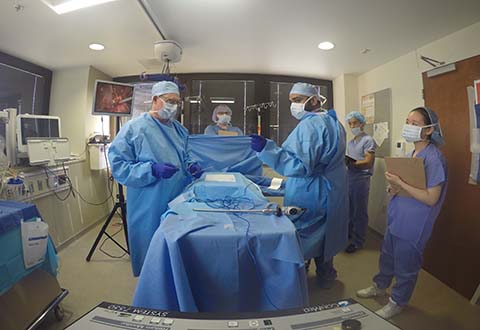VHA National Center for Patient Safety
Pittsburgh VA's Center for Medical Product Testing

NCPS manages several PSCIs which develop and implement clinical innovations that improve patient safety throughout VHA. One such PSCI is the Center for Medical Product End-user Testing (CMPET) at the Pittsburgh VA.
Pittsburgh’s Center for Medical Product End-User Testing
The VA National Center for Patient Safety (NCPS) manages several Patient Safety Centers of Inquiry (PSCI) which develop, disseminate and implement clinically relevant innovations that improve patient safety throughout the Veterans Health Administration (VHA).
One such PSCI is the Center for Medical Product End-user Testing (CMPET) located at the VA Pittsburgh Healthcare System (VAPHS). CMPET assesses the risk for medical product use-related hazards with the goal of reducing or preventing adverse events across VHA. CMPET focuses on the use of human factors principles to improve patient safety, an NCPS high-priority area of study. CMPET conducts human factors evaluations involving the intended users of medical products performing representative tasks under variable and sometimes stressful conditions. CMPET’s three-year plan involves the completion of projects to support the NCPS Purchasing for Safety initiative.
The NCPS Purchasing for Safety initiative prioritized electrosurgical units (ESUs) as the medical product for CMPET to evaluate in fiscal year 2016. ESUs are used for surgical cutting and controlling bleeding by causing coagulation (hemostasis) at the surgical site. The FDA received over 23,000 reports of adverse events associated with ESUs over a seven-year period, with one of the most serious use-related hazards being charring of healthy tissue. Three commonly reported use errors that could result in charring of healthy tissue are: (1) setting the incorrect power, (2) connecting the incorrect instruments, and (3) selecting the incorrect mode. CMPET staff conducted three separate studies to investigate each use error individually. In each study, CMPET staff compared two ESU models. The objective was to identify the specific ESU design features that can help prevent or mitigate these use errors.
Thirty-five registered nurses and one medical technician who use ESUs as part of their primary duties at VAPHS participated in all three studies. The evaluation took place in an unused isolation room in the post anesthesia care unit at VAPHS. To simulate a real-world operating room (OR) environment, the isolation room was equipped with technology used during a typical surgery. Two standardized actors from the University of Pittsburgh portrayed OR staff who interacted with the participant during the scenario. The standardized actors followed a script to guide the participant through the scenario. Three study co-investigators portrayed OR staff who were present in the room, but did not interact with the participant. The study co-investigators observed whether the participant completed the requested task correctly and how long it took them to complete the task. After using each ESU model, the principal investigator interviewed the participant to obtain feedback about the interface design features that supported or hindered accurate and efficient task completion.
Once analyses are complete, CMPET staff will upload the results tables onto the CMPET SharePoint site, where VHA stakeholders can access results from this and previous CMPET medical product evaluations. Stakeholders can use the results to ensure that VHA facilities are purchasing ESUs that are less likely to elicit use errors. This can reduce the burden of risk experienced by Veterans undergoing surgical procedures in which ESUs are utilized.



















